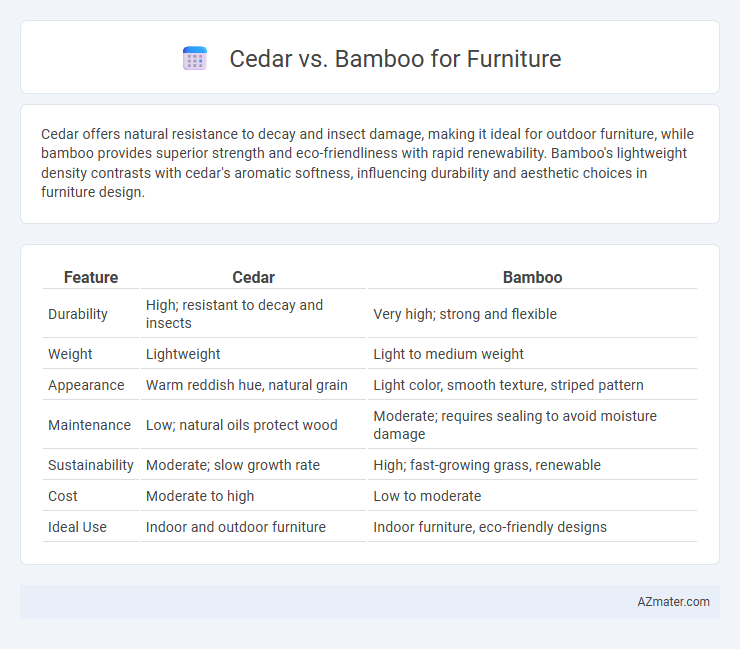Cedar offers natural resistance to decay and insect damage, making it ideal for outdoor furniture, while bamboo provides superior strength and eco-friendliness with rapid renewability. Bamboo's lightweight density contrasts with cedar's aromatic softness, influencing durability and aesthetic choices in furniture design.
Table of Comparison
| Feature | Cedar | Bamboo |
|---|---|---|
| Durability | High; resistant to decay and insects | Very high; strong and flexible |
| Weight | Lightweight | Light to medium weight |
| Appearance | Warm reddish hue, natural grain | Light color, smooth texture, striped pattern |
| Maintenance | Low; natural oils protect wood | Moderate; requires sealing to avoid moisture damage |
| Sustainability | Moderate; slow growth rate | High; fast-growing grass, renewable |
| Cost | Moderate to high | Low to moderate |
| Ideal Use | Indoor and outdoor furniture | Indoor furniture, eco-friendly designs |
Introduction to Cedar and Bamboo Furniture
Cedar furniture is prized for its natural resistance to decay, insects, and moisture, making it ideal for outdoor and indoor use, while its aromatic scent adds a distinctive appeal. Bamboo furniture offers an eco-friendly alternative due to its rapid growth and sustainability, featuring lightweight yet durable characteristics that suit modern and contemporary designs. Both materials provide unique aesthetic qualities and functional benefits, with cedar often preferred for its rich color and grain and bamboo valued for its strength and renewable properties.
Material Origins: Cedar vs Bamboo
Cedar originates from coniferous trees primarily found in North America and the Mediterranean, known for its natural oils that provide insect resistance and a pleasant aroma. Bamboo is a fast-growing grass predominantly cultivated in Asia, prized for its sustainability and remarkable tensile strength, making it an eco-friendly alternative in furniture production. Both materials offer unique environmental benefits; cedar's durability comes from its resinous wood, while bamboo's rapid renewability ensures minimal ecological impact.
Durability and Strength Comparison
Cedar offers moderate durability with natural resistance to rot and insects, making it ideal for indoor and sheltered outdoor furniture, while bamboo boasts exceptional strength due to its dense fiber structure, outperforming many hardwoods in tensile strength. Bamboo's rapid growth and environmentally friendly harvesting contribute to its popularity in sustainable furniture production, yet cedar provides a warmer, more aromatic finish preferred in classic wood furniture. For applications requiring maximum toughness and longevity, bamboo furniture is favored, though cedar remains a durable choice for aesthetic and moderate use conditions.
Aesthetic Appeal and Design Versatility
Cedar furniture showcases a rich, warm reddish hue and pronounced grain patterns that enhance rustic and traditional aesthetics. Bamboo offers a sleek, light-toned appearance with smooth texture, ideal for modern, minimalist, and eco-friendly designs. Bamboo's flexibility allows for diverse shapes and innovative structures, while cedar's sturdiness suits classic, carved craftsmanship.
Environmental Impact and Sustainability
Cedar furniture offers natural resistance to decay and insects, requiring less chemical treatment and thus reducing environmental pollution compared to other woods. Bamboo grows rapidly, sequesters more carbon dioxide per hectare than many trees, and regenerates quickly after harvest, making it a highly sustainable material for furniture production. Both materials contribute to eco-friendly furniture choices, but bamboo's fast growth cycle and high carbon absorption make it particularly advantageous for reducing carbon footprints.
Maintenance and Longevity
Cedar furniture requires periodic sealing or oiling to maintain its resistance to moisture and insect damage, ensuring durability over time. Bamboo furniture offers exceptional longevity with minimal maintenance, as its dense fibers naturally repel water and pests, making it ideal for both indoor and outdoor use. While cedar may need more frequent upkeep to prevent weathering, bamboo's hardiness and natural preservatives contribute to a longer-lasting, low-maintenance furniture option.
Cost and Affordability Analysis
Cedar furniture typically costs more upfront due to its natural resistance to decay and insect damage, making it a long-lasting choice that justifies the higher price. Bamboo furniture offers a more affordable option with rapid renewability and high strength, balancing initial savings with sustainability benefits. When comparing cost and affordability, bamboo provides budget-friendly furniture ideal for eco-conscious consumers, while cedar appeals to those prioritizing durability and natural weather resistance.
Resistance to Pests and Weather
Cedar wood exhibits superior resistance to pests like termites and wood-boring insects due to its natural oils and aromatic compounds, making it ideal for outdoor furniture exposed to harsh weather conditions. Bamboo, while durable and flexible, is more susceptible to insect infestation and requires proper treatment to withstand moisture and prolonged exposure to the elements. The inherent pest-repellent properties and weather durability of cedar typically ensure longer lifespan and lower maintenance compared to untreated bamboo furniture.
Best Use Cases for Cedar and Bamboo
Cedar excels in outdoor furniture due to its natural resistance to moisture, decay, and insect damage, making it ideal for garden benches, patio sets, and deck chairs. Bamboo, with its rapid growth and high tensile strength, suits indoor furniture such as dining tables, shelving, and flooring where sustainability and durability are priorities. Both materials offer eco-friendly options, but cedar's aromatic properties also repel pests, enhancing its suitability for outdoor use.
Final Verdict: Choosing the Right Material
Cedar offers natural resistance to decay and insects, making it ideal for outdoor furniture, while bamboo provides superior strength and sustainability with rapid growth cycles. Cedar's warm tones and aromatic qualities appeal to aesthetic preferences, whereas bamboo's lightweight, flexible structure suits modern, eco-friendly designs. Selecting the right material depends on factors such as durability needs, environmental impact, and intended furniture style, with cedar excelling in longevity and bamboo leading in renewability.

Infographic: Cedar vs Bamboo for Furniture
 azmater.com
azmater.com